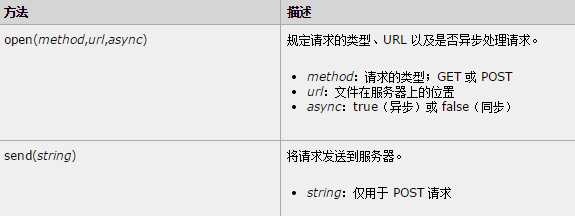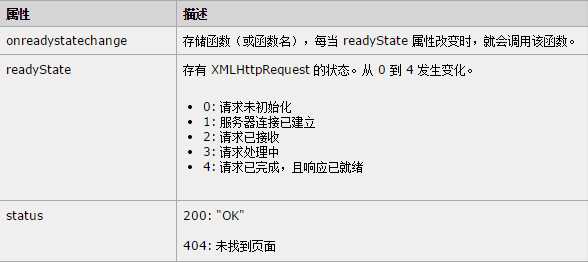标签:
一、Ajax基础
1. Ajax简介
Ajax=Asynchronous JavaScript And XML(异步的javaScript和XML)。
Ajax不是一门新的编程语言,是一种用于创建快速动态网页的技术。
通过与服务器进行少量数据交换,Ajax可以使网页实现异步更新。也即是在不重新加载整个页面的情况下,对网页的某个部分进行更新。
而传统的网页(不使用Ajax)如果要更新内容,必须重载整个页面。浪费网络流量带宽。
2. Ajax的工作原理
通过一个实例,讲解Ajax的工作原理:
1)新建一个AjaxTest的web应用,编辑index.html如下:
<html>
<head>
<script type="text/javaScript">
function loadXMLDoc( ){
var xmlhttp;
if (window.XMLHttpRequest)
{
xmlhttp= new XMLHttpRequest();
}else{
xmlhttp= new ActiveXObject("Microsoft.XMLHTTP" );
}
xmlhttp.onreadystatechange= function()//接收响应更新页面显示
{
if (xmlhttp.readyState==4 && xmlhttp.status==200)
{
document.getElementById( "myDiv").innerHTML=xmlhttp.responseText;
}
};
xmlhttp.open( "GET","DealResServlet" ,true);
xmlhttp.send();//发送请求
}
</script>
</head>
<body>
<div id="myDiv"><h3>Let Ajax change this text!</h3></div>
<button type="button" onclick="loadXMLDoc( )">changeContext</button>
</body>
</html>
2)在src目录下新建一个Servlet处理请求:DealResServlet.java
代码如下:
package com.servlet;
import java.io.IOException;
import java.io.PrintWriter;
import javax.servlet.ServletException;
import javax.servlet.annotation.WebServlet;
import javax.servlet.http.HttpServlet;
import javax.servlet.http.HttpServletRequest;
import javax.servlet.http.HttpServletResponse;
@WebServlet(name="DealResServlet" ,urlPatterns = "/DealResServlet")
public class DealResServlet extends HttpServlet {
private static final long serialVersionUID = 1L;
protected void doGet(HttpServletRequest request, HttpServletResponse response ) throws ServletException, IOException {
PrintWriter out = response .getWriter();
out.write("hello Ajax" );
}
}
部署web应用,在浏览器地址栏输入:http://localhost:8080/AjaxTest/index.html

点击按钮后,页面发送请求给服务器,对应的Servlet处理该请求,返回响应。

二、Ajax中的XMLHttpRequest对象:也即XHR对象
XMLHttpRequest 对象是Ajax技术的基础也是主要对象,所有现在的浏览器均支持XMLHttpRequest对象(IE5、IE6使用ActiveXObject)
1. XMLHttpRequest 对象的创建
所有现在的浏览器(IE7+、Firefox、Chrome、Safari、Opera)均内建了XMLHttpRequest对象
varible = new XMLHttpRequest( );
老版本的IE使用ActiveXObject对象:varible = new ActiveXObject("Microsoft.XMLHTTP");
为了应对所有现在的浏览器,包括IE5、6,在使用XHR时,应该检查浏览器是否支持XMLHttpRequest对象,如果支持,创建XMLHttpRequest对象,如果不支持,则创建ActiveXObject:
var xmlhttp;
if(window.XMLHttpRequest ){
xmlhttp = new XMLHttpRequest( );
}else{
xmlhttp = new ActiveXObject("Microsoft.XMLHTTP" );
}
2. XMLHttpRequest请求
XMLHttpRequest对象用于和服务器交换数据
---------------------------------------------------------------------------------------------------
向服务器发送请求:
将请求发送给服务器,使用XMLHttpRequest 对象的两个函数:open()和send()
xmlhttp.open( "GET", "", true);
xmlhttp.send( );


---------------------------------------------------------------------------------------------------
GET还是POST的选择?
与POST相比,GET更简单更快,在大多数情况下使用。
在以下情况下,需使用POST方法:
1)无法使用缓存文件(更新服务器上的文件或数据库)
2)向服务器发送大量数据(POST没有数据量限制)
3)发送包含未知字符的用户输入时,POST比GET更稳定更可靠
---------------------------------------------------------------------------------------------------
GET请求
xmlhttp.open("GET","url",true);
xmlhttp.send( );
---------------------------------------------------------------------------------------------------
在上面的例子,可能得到的是缓存的结果。
为了避免这种情况,向URL添加一个唯一的ID。
xmlhttp.open("GET","url?t="+Math.random( ),true);
xmlhttp.send( );
--------------------------------------------------------------------------------------------------
如果希望通过GET请求发送消息,请向URL添加信息。
xmlhttp.open("GET","url?name=zwbg&age=23”,true);
xmlhttp.send( );
实例:
<html>
<head>
<script type="text/javaScript">
function loadXMLDoc( ){
var xmlhttp;
if (window.XMLHttpRequest)
{
xmlhttp= new XMLHttpRequest();
}else{
xmlhttp= new ActiveXObject("Microsoft.XMLHTTP" );
}
xmlhttp.onreadystatechange= function()//接收响应更新页面显示
{
if (xmlhttp.readyState==4 && xmlhttp.status==200)
{
document.getElementById( "myDiv").innerHTML=xmlhttp.responseText;
}
};
xmlhttp.open( "GET","DealResServlet2?name=zwbg&age=23" ,true);
xmlhttp.send();//发送请求
}
</script>
</head>
<body>
<div id="myDiv"><h3>Ajax Info</h3></div>
<button type="button" onclick="loadXMLDoc( )">获取数据</button>
</body>
</html>
其中DealResServlet2主要代码为:
protected void doGet(HttpServletRequest request, HttpServletResponse response) throws ServletException, IOException {
String name = request .getParameter("name");
String age = request .getParameter("age");
PrintWriter out = response .getWriter();
out.write("name: " +name +"<br>" );
out.write("age: " +age );
}


---------------------------------------------------------------------------------------------------
POST请求:
一个简单的POST请求:
xmlhttp.open("POST","url",true);
xmlhttp.send( );
如果需要向HTML表单那样POST数据,首先必须使用setRequestHeader( )来添加HTTP请求头。然后在send()方法中规定你希望发送的数据:
xmlhttp.open("POST","url",true);
xmlhttp.setRequestHeader("Content-type","application/x-www-form-urlencoded");
xmlhttp.send("fname=Bill&lname=Gates");//发送的消息

url--服务器上的文件
open()方法的url参数是服务器上文件的地址:
该文件可以是任何类型的文件,比如.txt .xml或者服务器脚本。.asp或者.php(在传回响应时能够执行任务)
异步:-True或False
Ajax指的是异步的js 和xml
XMLHttpRequest对象如果是用于Ajax的话,其open()方法的asyn参数设置为true
xmlhttp.open("GET","url",true);
对于web程序员来讲,发送异步请求是一种进步,很多服务器执行的任务相当费时,Ajax出现之前,可能引起应用程序挂起或者停止(等待服务器响应)
通过Ajax,Javascript无需等待服务器响应。而是:
在等待服务器响应时执行其他脚本
在响应就绪后对响应进行处理
Asyn = true
当使用asyn=true时,请规定在响应处于onreadystatechange事件中的就绪状态时执行的函数:
xmlhttp.onreadystatechange = function( )
{
if( xmlhttp.readyState == 4&& xmlhttp.status==200)
{
document.getElementById("myDiv").innerHTML=xmlhttp.responseText;
}
}
xmlhttp.open("GET","",true);
xmlhttp.send( );
Asyn=false
一般不推荐使用aysn=false,但对于一些小的请求,也是可以的。
javaScript会等待服务器响应就绪后才继续执行。如果服务器繁忙或者缓慢,应用程序就会挂起或停止
注意:当aysn=false时,不要编写onreadystatechange函数,把代码放在send()语句后面即可。
xmlhttp.open("GET","",false);
xmlhttp.send( );
document.getElementById("myDiv").innerHTML=xmlhttp.responseText;
3.XMLHttpRequest响应
如果需要获取服务器的响应,使用XMLHttpRequest对象的responseText或者responseXML属性

responseText属性
如果服务器的响应不是XML,要使用responseText属性
responseText属性返回字符串形式的响应。
document.getElementById("myDiv").innerHTML = xmlhttp.responseText;
responseXML属性
如果服务器的响应时xml,而且需要作为XML对象进行解析,这时要使用responseXML属性
响应返回.xml文件,解析此响应:
在Servlet中设置response.setContentType("text/xml;charset=utf-8"); 告诉浏览器文档类型是xml,按照相应的规则解析。
4.Ajax--onreadystatechange事件
onreadystatechange事件:当请求被发送到服务器时,我们需要执行一些基于响应的任务。
每当readyState改变时,就会触发onreadystatechange事件
readyState属性存有XMLHttpRequest的状态信息
XMLHttpRequest对象的三个重要属性:

在onreadystatechange事件中,规定当服务器响应已做好被处理的准备时所执行的任务。
当readyState等于4且状态为200时,表示响应就绪:
xmlhttp.ononreadystatechange = function( ){
if( xmlhttp.readyState==4&&xmlhttp.status==200)
{
document.getElementById("myDiv").innerHTML = xmlhttp.responseText;
}
};
三 Ajax在web中的简单应用实例:
AJAX用于创建动态性更强的应用程序:
实例:--当用户在输入框输入字符时,网页和web服务器进行通信



其中index.html为:
<html>
<head>
<script type="text/javascript" >
function showHint(str)
{
var xmlhttp;
if (str.length==0)
{
document.getElementById( "txtHint").innerHTML="" ;
return;
}
if (window.XMLHttpRequest)
{ // code for IE7+, Firefox, Chrome, Opera, Safari
xmlhttp= new XMLHttpRequest();
}
else
{ // code for IE6, IE5
xmlhttp= new ActiveXObject("Microsoft.XMLHTTP" );
}
xmlhttp.onreadystatechange= function()
{
if (xmlhttp.readyState==4 && xmlhttp.status==200)
{
document.getElementById( "txtHint").innerHTML=xmlhttp.responseText;
}
};
xmlhttp.open( "GET","DealServlet3?testStr=" +str,true);
xmlhttp.send();
}
</script>
</head>
<body>
<h3> 请在下面的输入框中键入字母(A - H): </h3>
<form action="" >
姓氏: <input type="text" id="txt1" onkeyup="showHint(this.value)" />
</form>
<p> 建议:<span id="txtHint"></ span></p >
</body>
</html>
而处理请求的DealServlet3代码为:
package com.servlet;
import java.io.IOException;
import java.io.PrintWriter;
import javax.servlet.ServletException;
import javax.servlet.annotation.WebServlet;
import javax.servlet.http.HttpServlet;
import javax.servlet.http.HttpServletRequest;
import javax.servlet.http.HttpServletResponse;
@WebServlet(name="DealServlet3" ,urlPatterns="/DealServlet3")
public class DealServlet3 extends HttpServlet {
private static final long serialVersionUID = 1L;
protected void doGet(HttpServletRequest request, HttpServletResponse response ) throws ServletException, IOException {
String str = request .getParameter("testStr");
PrintWriter out = response .getWriter();
String[] names = {"Ami","Bob" ,"Cal" ,"Davi" ,"Ella" ,"Fill" ,"Gates" ,"Hebe" };
String temp=null ;
if(str .length()==1&&str.charAt(0)>= ‘A‘&&str .charAt(0)<=‘H‘){
for(int i =0;i<names.length;i++){
if(names [i ].charAt(0)==str.charAt(0)){
temp=names [i ];
break;
}
}
if(temp ==null){
out.write("no suggestion" );
} else{
out.write(temp );
}
} else{
out.write("no suggestion" );
}
}
}
该实例的执行过程分析:
.png)
当用户在上面的输入框输入字符时,会执行函数showHint( ),该函数由onkeyup事件触发:
如果输入框为空,则str.length==0则该函数清空txtHint占位符的内容,退出函数。
如果输入框不为空,showHint( )函数会执行:
1)创建XMLHttpRequest对象
2)当服务器就绪时执行函数
3)把请求发送到服务器上的文件进行处理
Ajax---基础
标签:
原文地址:http://www.cnblogs.com/zwbg/p/5902862.html












.png)